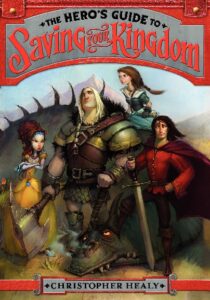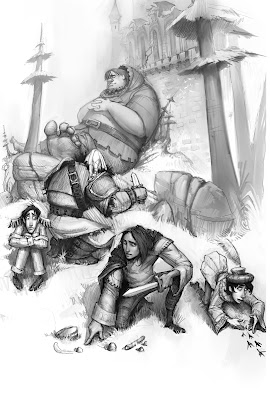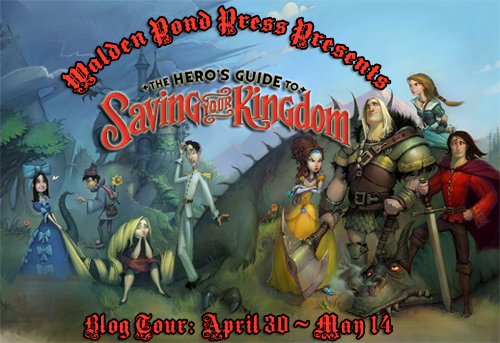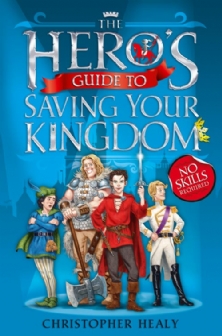Looking for some recommendations for a middle grader who loves fantasy? Well, we’ve got just the list for you!
Here are some stellar picks for the kid looking for magical powers, mysterious forests, heros, and villains to take to the beach with him.

THE THICKETY, by J. A. White, is the start of a new fantasy series set in a world where magic is forbidden but exists in the dark woods called the Thickety. This book would be a great recommendation for fans of the Septimus Heap series, and here’s a book talk prepared by librarian, author, and Common Core workshop presenter Kathleen Odean:
How would you like to have the power to summon amazing creatures to do your will? When Kara finds a book in the Thickety, a dangerous forest, it awakens her magical powers. Local villagers view magic as evil but for Kara, it’s a connection to her mother, who was executed as a witch. The spells thrill Kara until the magic starts to change her in frightening ways. Is Kara in control of the magic—or is it in control of her? If she doesn’t figure it out soon, she could lose everyone and everything she loves.
There’s even a Common Core-aligned discussion guide with activities written by the author, J. A. White—an elementary school teacher! (You may not want to send this to the beach, though. Maybe save it for September.)

THE CASTLE BEHIND THORNS, by Schneider Award winner Merrie Haskell, is a magical adventure set in an enchanted castle that will appeal to fans of Gail Carson Levine, Karen Cushman, and Shannon Hale.
When Sand wakes up alone in a long-abandoned castle, he has no idea how he got there. Everything in the castle—from dishes to candles to apples—is torn in half or slashed to bits. Nothing lives here and nothing grows, except the vicious, thorny bramble that prevents Sand from leaving. To survive, Sand does what he knows best—he fires up the castle’s forge to mend what he needs to live. But the things he fixes work somehow better than they ought to. Is there magic in the mending, granted by the saints who once guarded this place? With gorgeous language and breathtaking magic, THE CASTLE BEHIND THORNS tells of the power of memory and story, forgiveness and strength, and the true gifts of craft and imagination.
Thinking ahead to the new school year, Common Core applications include: Comparing and contrasting texts in different forms or genres; determining the meaning of words and phrases as they are used in a text, including figurative and connotative meanings; and analyzing the impact of a specific word choice on meaning and tone.

THE DYERVILLE TALES, by M. P. Kozlowsky, tells the story of a young orphan who searches for his family and the meaning in his grandfather’s book of lost fairy tales.
Vince Elgin is an orphan, having lost his mother and father in a fire when he was young. With only a senile grandfather he barely knows to call family, Vince was interned in a group home, dreaming that his father, whose body was never found, might one day return for him. When a letter arrives telling Vince his grandfather has passed away, he is convinced that if his father is still alive, he’ll find him at the funeral. He strikes out for the small town of Dyerville carrying only one thing with him: his grandfather’s journal. The journal tells a fantastical story of witches and giants and magic, one that can’t be true. But as Vince reads on, he finds that his very real adventure may have more in common with his grandfather’s than he ever could have known.
If you’d like to bring this one into your classroom next year, Common Core applications include: Determining the meaning of words and phrases as they are used in a text; analyzing the impact of a specific word choice on meaning and tone; describing how a particular story’s plot unfolds in a series of episodes; and describing how the characters respond or change as the plot moves toward a resolution.

THE HERO’S GUIDE TO BEING AN OUTLAW, by Christopher Healy, is the hilarious and action-packed conclusion to the acclaimed hit series that began with THE HERO’S GUIDE TO SAVING YOUR KINGDOM.
Prince Liam. Prince Frederic. Prince Duncan. Prince Gustav. You think you know those guys pretty well by now, don’t you? Well, think again. Posters plastered across the thirteen kingdoms are saying that Briar Rose has been murdered—and the four Princes Charming are the prime suspects. Now they’re on the run in a desperate attempt to clear their names. Along the way, however, they discover that Briar’s murder is just one part of a nefarious plot to take control of all thirteen kingdoms—a plot that will lead to the doorstep of an eerily familiar fortress for a final showdown with an eerily familiar enemy.
And Common Core applications for this one include: Explaining how an author develops the point of view of the narrator or speaker in a text; comparing and contrasting texts in different forms or genres; and analyzing how differences in the points of view of the characters and the reader (e.g., created through the use of dramatic irony) create such effects as suspense or humor.
Happy reading!
My list of family favorites is skewed toward books or series my wife and I have been able to share and enjoy with our two daughters (ages 9 and 6). We have many other favorites, but unlike the characters in my own books, I’m a notorious rule follower. So here are just five that have had the biggest impact so far.
 The Hero’s Guide to Saving Your Kingdom
The Hero’s Guide to Saving Your Kingdom
By Christopher Healy
Walden Pond Press (an imprint of Harper Collins)
$16.99
ISBN: 978-0-06-211743-4
Ages 9-12
On shelves now.
Since when did fairytales become the realm of the girly? I blame Disney. Back in the days of Grimm your average everyday fairytale might contain princesses and pretty gowns and all that jazz, but it was also just as likely to offer its own fair share of dragons and murderers and goblins as well. Once the Disney company realized that princesses were magnificent moneymakers, gone was the gore and the elements that might make those stories appealing to the boy set. If you actually sat down and watched the films you’d see plenty of princes fighting beasts (or fighting beast princes) but the very idea of “Sleeping Beauty” or “Snow White” or any of those films has taken on a semi-sweet and sickly vibe. By the same token, it’s hard to find fractured fairytale children’s novels that can be loved just as much by boys as by girls. The great equalizer of all things is, to my mind, humor. Make something funny and gender is rendered irrelevant. There are certainly a fair number of funny fairytale-type stories out there, but to my mind none are quite so delightful and hilarious as Christopher Healy’s newest series. Starting with The Hero’s Guide to Saving Your Kingdom (and followed by The Hero’s Guide to Storming the Castle), Healy takes that most maligned of all fairytale characters and finally gives “him” a voice. You heard right. Prince Charming is finally getting his due.
Meet Princes Liam, Frederic, Duncan, and Gustav. If their names don’t ring a bell with you, don’t be too surprised. Known better by their pseudonym “Prince Charming” the princes are a bit peeved at the lousy P.R. their adventures have garnered. The bards have found that their stories tell better when the girls get all the credit (and actual names) and it isn’t just the princes that are peeved. A local witch is more than a little upset, and that anger may have something to do with the slow disappearance of the bards themselves. Now it’s up to our four heroes, brought together through the strangest of circumstances, to band together to defeat an evil witch, strike down a giant or two, outwit bandits, and generally find a way to make their faults into strengths.
 I take a gander at debut author Christopher Healy’s credentials and I am oddly pleased. A reviewer of children’s books and media he has written for Cookie, iVillage, Parenting, Time Out New York Kids, and Real Simple Family. In short, he’s from the parenting sphere. Clearly he’s taken what he’s learned and applied it here because it’s his wordplay that stands out. For example, he might list the jobs Cinderella has to perform as using “every waking hour performing onerous tasks, like scrubbing grout or chipping congealed mayonnaise from between fork tines.” By the same token, the sneaky sidenote is a delicate beast. It requires of the author a bit of finesse. Go too far as a writer for children and you end up amusing only the adults who happen to pick up your book. With this in mind, Healy is a sneaky sidenote master. He’ll give away a detail about the future and then say, “Oops, sorry about that. I probably should have said, `Spoiler alert’.” That’s 21st century foreshadowing for you. Or he might sneak in a Groucho Marx reference like “Captain Spaulding” once in a while, but it works within the context of the story (and amuses reviewers like myself in the meantime). Or he’ll mention that part of the witch’s plan is shooting bears at people out of cannons. It’s hard not appreciate a mind that comes up with that kind of thing.
I take a gander at debut author Christopher Healy’s credentials and I am oddly pleased. A reviewer of children’s books and media he has written for Cookie, iVillage, Parenting, Time Out New York Kids, and Real Simple Family. In short, he’s from the parenting sphere. Clearly he’s taken what he’s learned and applied it here because it’s his wordplay that stands out. For example, he might list the jobs Cinderella has to perform as using “every waking hour performing onerous tasks, like scrubbing grout or chipping congealed mayonnaise from between fork tines.” By the same token, the sneaky sidenote is a delicate beast. It requires of the author a bit of finesse. Go too far as a writer for children and you end up amusing only the adults who happen to pick up your book. With this in mind, Healy is a sneaky sidenote master. He’ll give away a detail about the future and then say, “Oops, sorry about that. I probably should have said, `Spoiler alert’.” That’s 21st century foreshadowing for you. Or he might sneak in a Groucho Marx reference like “Captain Spaulding” once in a while, but it works within the context of the story (and amuses reviewers like myself in the meantime). Or he’ll mention that part of the witch’s plan is shooting bears at people out of cannons. It’s hard not appreciate a mind that comes up with that kind of thing.
 In his New York Times review of the book Adam Gopnik took issue with the sheer enjoyment one can have with the book, going so far as to say, “Each page offers something to laugh at, but it can be an effort to turn each page.” His objections were steeped in the world building happening here, unfavorably comparing it to The Princess Bride (an unfair comparison if ever there was one) and even shooting quite low when he dared to invoke the name of the Shrek films. Oog. The fact of the matter is that if you’re looking for deep insightful probes into the human psyche, this is not the book for you. If you are looking for a perfectly fun story that meanders a bit but always stays on its feet, here’s your book. The princes are broad portraits, stereotypes that break out of their chosen roles, if reluctantly. They are also fellows you would follow from book to book to book. They have on-page chemistry (my wordier version of on-screen chemistry). You believe in these guys and you want them to succeed and not get beaten up too badly. It’s a fun and funny book and though it won’t win huge children’s literature awards it will be adored by its readership and discussed at length on the playgrounds of this good great nation. And that is just fine and dandy with me.
In his New York Times review of the book Adam Gopnik took issue with the sheer enjoyment one can have with the book, going so far as to say, “Each page offers something to laugh at, but it can be an effort to turn each page.” His objections were steeped in the world building happening here, unfavorably comparing it to The Princess Bride (an unfair comparison if ever there was one) and even shooting quite low when he dared to invoke the name of the Shrek films. Oog. The fact of the matter is that if you’re looking for deep insightful probes into the human psyche, this is not the book for you. If you are looking for a perfectly fun story that meanders a bit but always stays on its feet, here’s your book. The princes are broad portraits, stereotypes that break out of their chosen roles, if reluctantly. They are also fellows you would follow from book to book to book. They have on-page chemistry (my wordier version of on-screen chemistry). You believe in these guys and you want them to succeed and not get beaten up too badly. It’s a fun and funny book and though it won’t win huge children’s literature awards it will be adored by its readership and discussed at length on the playgrounds of this good great nation. And that is just fine and dandy with me.
 Considering how many contemporary updates to fairytales there are in pop culture right now (Once Upon a Time, Grimm, Snow White & The Huntsman, etc.) it’s strange to me that I can’t think of a book to quite compare with this one. A book that takes standard fairytales and familiar characters, renders them unfamiliar but human, and then loads the storyline up with bucketfuls of humor. I mean, books like A Tale Dark and Grimm and In a Glass Grimmly are newfound looks at old standards but they haven’t the light bouncy breezy quality of Healy’s work. These are fairytales for folks who love Disney, hate Disney, love fractured fairytales, love the original fairytales, and/or just like a good story in general. It’s perfect bedtime fare and ideal for those kids who want something amusing to read on their own. You know when a kid walks up to you and says they want a “funny” book? This is for them as well. Basically it’s for everyone, fantasy fans and fantasy haters alike. If ever you feel sick of the sheer seriousness of some fantasies (*cough* Eragon *cough*), this is a book for you too. Put it on your To Read list and pronto.
Considering how many contemporary updates to fairytales there are in pop culture right now (Once Upon a Time, Grimm, Snow White & The Huntsman, etc.) it’s strange to me that I can’t think of a book to quite compare with this one. A book that takes standard fairytales and familiar characters, renders them unfamiliar but human, and then loads the storyline up with bucketfuls of humor. I mean, books like A Tale Dark and Grimm and In a Glass Grimmly are newfound looks at old standards but they haven’t the light bouncy breezy quality of Healy’s work. These are fairytales for folks who love Disney, hate Disney, love fractured fairytales, love the original fairytales, and/or just like a good story in general. It’s perfect bedtime fare and ideal for those kids who want something amusing to read on their own. You know when a kid walks up to you and says they want a “funny” book? This is for them as well. Basically it’s for everyone, fantasy fans and fantasy haters alike. If ever you feel sick of the sheer seriousness of some fantasies (*cough* Eragon *cough*), this is a book for you too. Put it on your To Read list and pronto.
On shelves now.
Source: Galley sent from publisher for review.
Like This? Then Try:
First Sentence: “Prince Charming is afraid of old ladies. Didn’t know that, did you?”
Book Jacket Nattering: Love it. It’s nice when a cover artist makes it clear that they actually read the book. And Todd Harris must have read this puppy several times because not only are his cover illustrations dead on, the interior ones are great as well. Mind you, I have had a lot of kids complain to me about the fact that though the four princes do appear on both the front and back covers of this book, if you look just at the front cover only two of them made the cut with Sleeping Beauty and Cinderella thrown on there as well. This problem has been fortunately remedied with the sequel where you will find all four of our heroes front and center. Here’s the full front and back of the first book’s cover:

Oh. And love that British cover, I do. Just not as much.

Other Blog Reviews:
Professional Reviews:
Misc:
- The official website is here.
Video:
- And here’s an interview with the author, who is rather charming himself. Clearly he writes what he knows.
- And a Vlog Review. Awwwww.



















This book is delightful. My one concern when I read it was that it was a little long and meandered a bit, but your point about wanting to follow the characters is what truly matters. I gave it to my daughter and she loved every word and every page. (She read it over the summer and is in third grade now.) She absolutely can not wait for THE HERO”S GUIDE TO STORMING THE CASTLE and actually jumped up and down when I showed her what the cover looked like and what the title would be.
Also in this vein is the Ever After Series: book 1 was Of Giants and Ice-
Aw geez. I totally should have mentioned that first Ever After book. I did read it, after all. I may have to update the post to include it. It really is a good similar book.
Here’s my review, Betsy: http://www.sonderbooks.com/Childrens_Fiction/heros_guide.html And I named it a 2012 Sonderbooks Stand-out: http://www.sonderbooks.com/Standouts2012.html